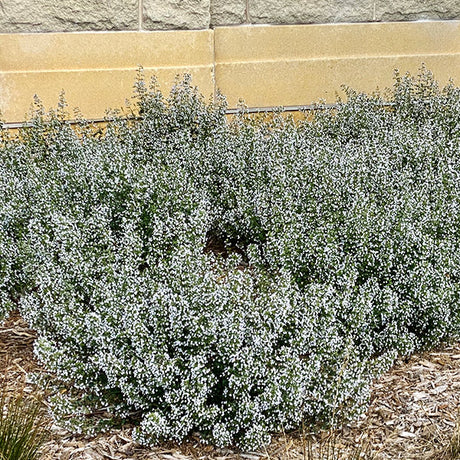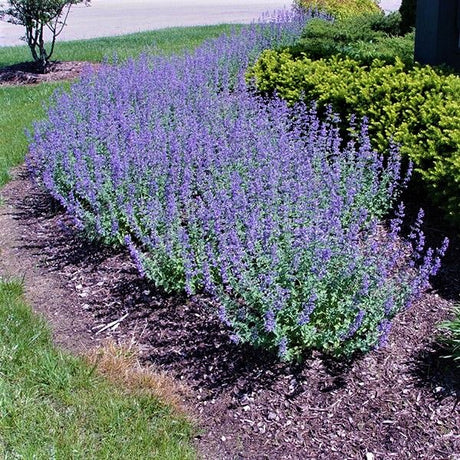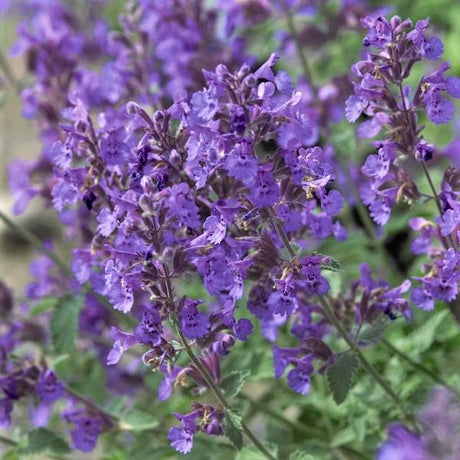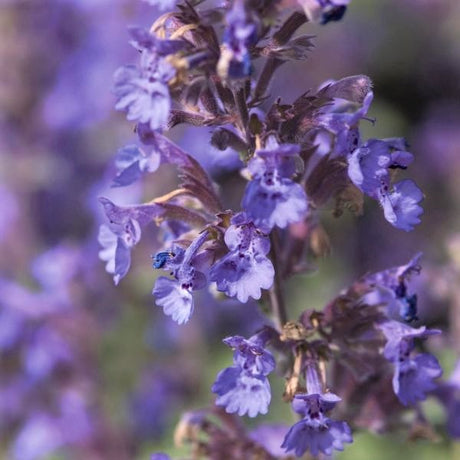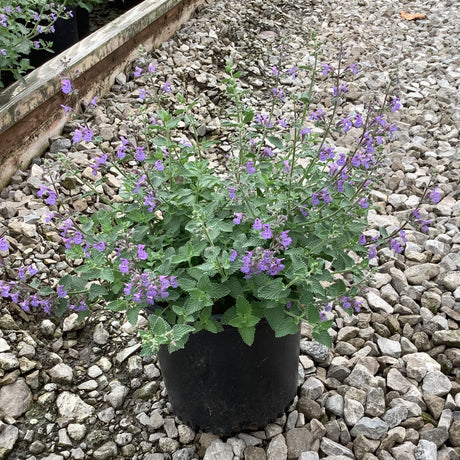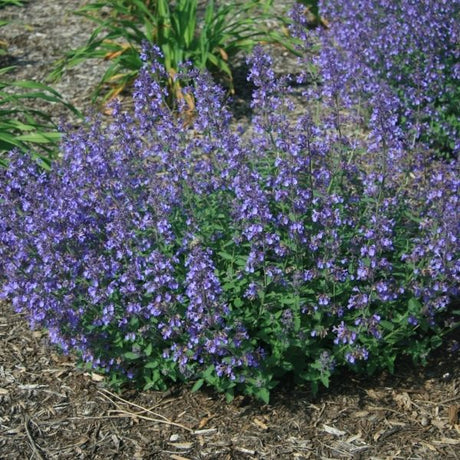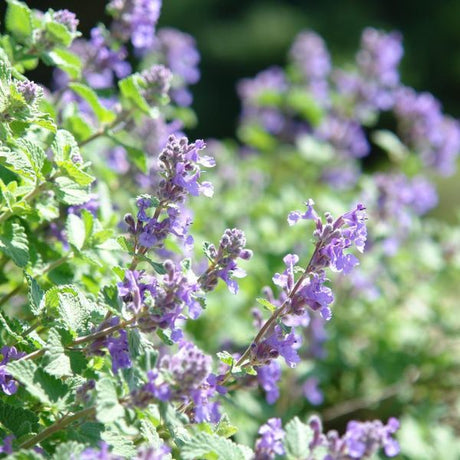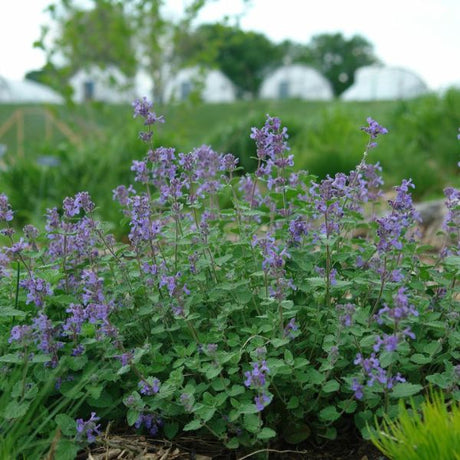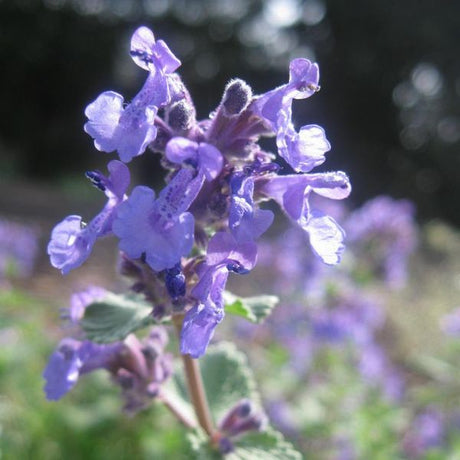- 7% off
Nepeta x faassenii 'Walker's Low'
Sale price $2817 Regular price $3023Unit price /Unavailable - 18% off
Nepeta x faassenii 'Novanepjun'
Sale price $3017 Regular price $3687Unit price /Unavailable - Sold out
- Sold out
- Sold out
- Sold out
Nepeta faassenii 'Dropmore'
Regular price $3482Unit price /Unavailable- Sold out
Nepeta faasenii 'Six Hills Giant'
Regular price $000Unit price /Unavailable
Catmint Plants (Nepeta) – Aromatic, Hardy, and Pollinator-Friendly Perennials
Catmint (Nepeta) is a large and beloved family of aromatic, ornamental perennials known for their soft texture, long bloom time, and easy care. While native to Europe and Asia, Catmint plants have naturalized beautifully across the U.S., thriving in sunny gardens, xeriscapes, and containers alike.
With their fuzzy, scalloped leaves and spires of lavender-blue, white, or pink flowers, Catmint adds color and fragrance from late spring through fall. These nectar-rich blooms attract bees, butterflies, hummingbirds, and other beneficial insects, making them a pollinator favorite.

Why Gardeners Love Catmint
These charming perennials form square, branched stems typical of the mint family, usually growing between 1 to 3 feet tall. You can easily pinch back the stems to keep them compact and encourage bushier growth.
They’re wonderfully fragrant from top to bottom and bloom generously from late spring into summer, often reblooming through fall when deadheaded regularly.
Catmint is a close cousin to Catnip, and yes! Many cats find it just as delightful! When bruised or dried, the leaves release an irresistible scent that encourages playful rolling and purring. You can even dry the leaves for homemade cat treats or toys.
Calamint (Clinopodium) is a close relative of Catmint, sharing the same aromatic foliage, clouds of white blooms, and major pollinator appeal, but offering a finer texture and a delightful minty fragrance that lasts all season.

Top Catmint Varieties for Every Landscape
Whether you’re planting borders, containers, or naturalized areas, there’s a Catmint variety for every space:
-
Neptune Catmint: Compact and colorful, perfect for edging and facer plantings.
-
Cat’s Pajamas Catmint: Floriferous and tidy, ideal for small gardens and containers.
-
Dropmore Ornamental Catnip: Low-growing beauty under 12 inches tall.
-
Six Hills Giant Catmint: Tall and lush, reaching about 3 feet for bold color impact.
- Whispurr™ Pink and Whispurr™ Blue Catmint: Big, fragrant blooms that bring movement and height.
- Calamint: Offers delicate, fragrant foliage and long-lasting blooms that attract bees and butterflies all summer long.
- Proven Winners® ColorChoice® Cat’s Meow Catmint: Spreading and self-sufficient, creating soothing waves of lavender-blue flowers.

These plants look incredible when planted en masse or used as fragrant borders and fillers in mixed perennial beds.
Easy-Care Perennial For Any Climate
Catmint plants are low-maintenance, heat-tolerant, and drought-resistant once established. They perform best in full sun but can tolerate light afternoon shade in hotter regions.
- Zones: Hardy from USDA Zones 3-10, depending on variety
- Soil: Adaptable to most well-drained soils
- Water: Moderate during establishment, minimal once mature
- Pruning: Cut back in late fall or early spring, and pinch for denser growth
- Blooming: Reblooming continues into fall with regular deadheading
You can divide Catmint in spring or allow it to self-seed naturally for effortless garden expansion.
Read more care and landscaping tips for Catmint here in our Garden Guide. Find your growing zone with the Plant Zone Map to ensure Catmint thrives in your area.
Key Benefits of Catmint
- Long-blooming, fragrant flowers
- Drought-tolerant and deer-resistant
- Pollinator magnet for bees, butterflies, and hummingbirds
- Attracts beneficial insects to boost garden health
- Great for borders and edging, container spillers, and mass planting
- Low-maintenance and heat-hardy once established
- Loved by cats but not invasive like true Mint
Shop Catmint Plants at Nature Hills Nursery
Bring home the beauty, fragrance, and reliability of Catmint perennials from Nature Hills Nursery. Each plant is grown with care and shipped securely to your door.
Shop the full Catmint collection today at NatureHills.com, and let these long-blooming perennials fill your garden with color and pollinator activity!
Family-owned and operated since 2001, Nature Hills Nursery is proud to offer plants backed by our Product Guarantee. Explore our full Planting Guide for expert growing advice.
FAQ's for Buying Catmint Online
What is the difference between Catmint and Catnip?
What is the difference between Catmint and Catnip?
While both belong to the Nepeta genus, Catmint (Nepeta faassenii) is primarily grown for ornamental landscaping, with showy blue or lavender flower spikes. Catnip (Nepeta cataria) is more pungent and primarily grown for its effect on cats. Catmint is often more attractive in the garden due to its longer blooming season and tidy growth habit.
Do Catmint plants attract pollinators?
Do Catmint plants attract pollinators?
Absolutely! Catmint is a magnet for bees, butterflies, and even hummingbirds. Its long bloom season from late spring through fall provides reliable nectar, making it a top choice for pollinator and wildlife gardens.
Is Catmint drought-tolerant?
Is Catmint drought-tolerant?
Yes! Once established, Catmint is exceptionally drought-tolerant and low-maintenance, making it perfect for xeriscaping and firewise gardens. It thrives in full sun and well-drained soil, requiring little supplemental watering after the first season.
Can Catmint be used as ground cover?
Can Catmint be used as ground cover?
Many varieties, like Cat’s Meow or Catnip, offer a spreading growth habit perfect for mass planting and ground cover. Use it to edge borders, fill open areas, or cascade over retaining walls and containers.
How do you care for Catmint to encourage reblooming?
How do you care for Catmint to encourage reblooming?
To keep Catmint blooming, deadhead faded flowers and prune midseason to encourage a fresh flush of growth. For a bushier shape and more flower spikes, pinch back new stems early in the season. Divide clumps every few years for healthy growth and more plants.

